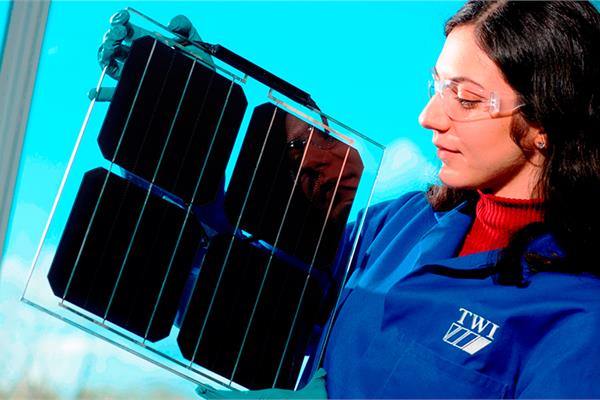
SolarSharc® was designed to meet the gap in the current solar photovoltaic (PV) market for a highly repellent, easy-to-clean solar panel coating which has a high level of mechanical and chemical durability, thereby removing the barriers to industry-wide adoption of coatings caused by existing product offerings.
The new SolarSharc® coating was created by a consortium of partners - the Advanced Resins and Coatings Innovation Centre (a strategic partnership between London South Bank University and TWI), Opus Materials Technologies, Onyx Solar, CEA - LITEN, Millidyne and TWI - who successfully secured funding for their project from the European Union's Horizon 2020 research and innovation programme (Grant agreement No. 760311). The patented technology behind SolarSharc® bonds multi-functionalised silica nanoparticles to a polymer matrix to produce a transparent, highly durable, self-cleaning, contamination repellent and cost-effective coating for solar panels.
In order to deliver a market ready product, the project aimed to take the coating from technology readiness level (TRL) 6 to TRL 9. This involved the development and deployment of a prototype which would be operationally tested and validated, followed by certification to the International Electrotechnical Commission (IEC) standard for solar PV, which would pave the way for future commercialisation. Earlier TRLs had been progressed through a previous project, Sol Plus, which formulated the original coating and received funding from Innovate UK.
Under the current project, a number of tests were undertaken to evaluate the coating including: the production process for the liquid; the deposition method onto solar PV panels; performance and behaviour of its properties, particularly when panels are subjected to tilting within a large-scale solar PV system; its optical properties; and it ability to withstand and repel surface contamination. For demonstration purposes, 48 solar panel modules, grouped into sets of six arrays, were tested outdoors in operational conditions, including segregation of soiling effects from weather-related factors, half of which were coated in SolarSharc® and the other half left uncoated. This made it possible to determine any influence the silicon technology being employed had on the electrical behaviour of the coating.
The test results showed that the coating was able to successfully reduce particle density over time on the surface of the solar PV glass, and that the panels it was deposited onto were able to generate more energy than those without the coating. Therefore, with SolarSharc®'s properties and efficacy now evidenced, the next steps are in progress to take the product to market including applying for the EIC standard as well as CE marking.
Geraldine Durand, Director of the Advanced Resins and Coatings Innovation Centre explained "With SolarSharc®, we can demonstrate to the solar PV industry that there is now a PV panel coating available, based on highly novel, disruptive technology, that is self-cleaning and leads to better panel performance over time due to the dual benefits of reducing dust accumulation and increasing light transmission." Adding "As a consortium, we are in a strong position to take SolarSharc® to the market place because each partner operates at a different stage of the solar PV supply chain and this will enable us to exploit the product's full potential for broad industry take-up."